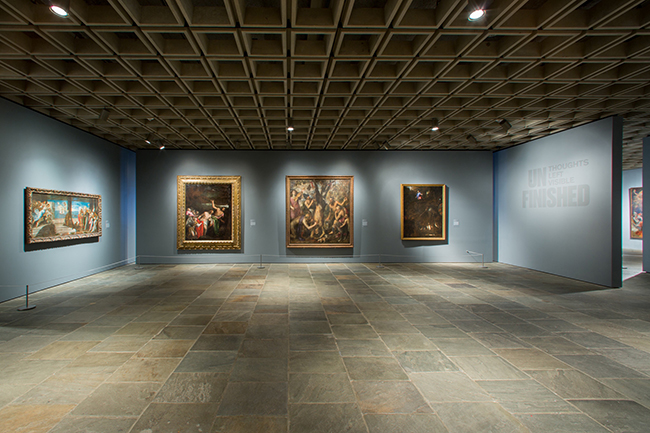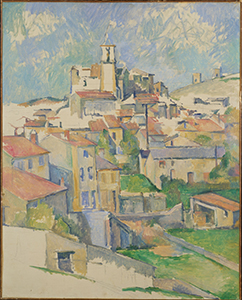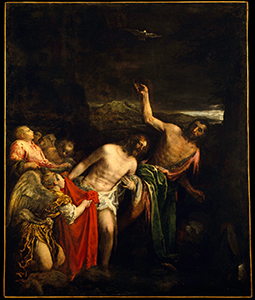The Met Moves Into the 21st Century

By Denise Mattia
The opening of the Met Breuer Museum on East 74th Street and Madison Avenue in Manhattan ushers in another exciting dimension of The Metropolitan Museum of Art with the exhibit “Unfinished, Thoughts Left Visible” and a retrospective of the works of Indian artist Nasreen Mohamedi.
“Unfinished” is a show waiting to happen,” said one enthusiastic New Yorker and frequent visitor to The Met. Forty percent of the 200-plus works that fill the Third and Fourth floors of Bauhaus architect Marcel Breuer’s iconic building are from The Met’s unparalleled collection, many never before seen. The balance of the works are on loan from major national and international collections.
In “Unfinished, Thoughts Left Visible,” the curators examine the process of the world’s great artists from the early Renaissance to the present, and ask the question “When did they deem their work finished”? What are the dialectics behind why works were left “unfinished?” Were they by accident, necessity, or intent?
 Paul Cézanne (French, 1839–1906) Gardanne 1885–1886 Oil on canvas 31 1/2 x 25 1/4 in. (80 x 64.1 cm) The Metropolitan Museum of Art, New York, Gift of Dr. and Mrs. Franz H. Hirschland, 1957
Paul Cézanne (French, 1839–1906) Gardanne 1885–1886 Oil on canvas 31 1/2 x 25 1/4 in. (80 x 64.1 cm) The Metropolitan Museum of Art, New York, Gift of Dr. and Mrs. Franz H. Hirschland, 1957The emotional intensity of Titian’s masterpiece confronts us as we exit the elevator on the Third floor. Color in The Flaying of Marsyas (c.1570) is restrained. People move freely around the canvas, with some areas intentionally raw and sketchily executed. The wall label suggests that the painting may be “unfinished,” or “more likely that the artist deliberately used the non-finito technique to best convey the tragic story.” For whatever reason, the original method would be carried through for generations.
Soon after Titian’s death, his student, Tintoretto (Jacopo Robusti) adopted the non-finito technique. Criticized for his haste because he accepted low prices for his work, the oil and canvas Doge Alvise Mocenigo (1507-1577) bears the unmistakable sketchy quality that remained in his body of work throughout his life.
A student of Rembrandt van Rijn described the master’s style as an “unusual abbreviated technique.” Rembrandt was searching for the essence of humanity by probing intensely into the psychology of his subjects – or perhaps his personal difficulties (in 1654 Rembrandt was forced to surrender his possessions to creditors). Light touches of thick paint achieve the luminous light qualities and rich, warm surfaces of the face and hand in his St. Bartholomew (1657) while the figure recedes into the dark brown background.
Considered a leader of the avant-garde painters by 1865, Manet painted typical Impressionist subjects, focusing on light and movement and reducing forms to spots and patches of tone. Of the three unfinished paintings of his wife, Suzanne Leenhoff, the Dutch pianist, one shows her face carefully painted. Manet, however, was discontented with it, repainted it twice and finally abandoned it.
The five seascapes of Joseph Mallord William Turner displayed in its gallery sum up his affinity with tumultuous, gale-swept seas and his occupation with light. His works appear ethereal dissolving into luminous color. The wall label of Margate (?) from the Sea 1835-40 notes, “Turner used brushes, a cloth, a palette knife, and possibly his hands to achieve the varied surfaces of this work, which was never exhibited by the artist and is presumed to be unfinished.”
As the power of the unfinished self-portrait by Edvard Munch, Alice Neel’s James Hunter Black Draftee, 1965 is a stark metaphor for a life cut off. Although only the Hunter’s face and hand are painted, Neel considered the work complete after he failed to return for his second sitting. Whether or not Hunter was killed in Viet Nam is unknown.
The exhibition continues on the Fourth floor with striking canvasses by Pablo Picasso that are typically pieced, un- or under-painted. Visible compositional changes to The Charnel House, 1944-45, reveal Picasso’s reaction to all brutal, inhuman acts of violence. Rubbed out expressions of the figures are incomplete, yet Picasso considered it finished sufficiently to donate, take back and finally sell. The wall text indicated that the painting is based either on the Fascist bombing of the Spanish Civil War or the Nazi concentration camps.
The oversized canvas of Untitled (Still Life), 2002 by Luc Tuymans is in tribute to a Cézanne Still Life. Tymans furtive, sparse coloration depicts the process of the master’s oeuvres, several of which are located opposite the Tuymans’ wall. Unlike the impressionists who strove to capture momentary visual sensations, Paul Cézanne studied the relationship between objects and subjects, constructing radiant paintings in thin, almost transparent washes. His aesthetic embraced the unresolved non-finito – intentionally unfinished style. According to the wall label, Cézanne shunned “long-standing conventions as to when a work was complete.”
 Jacopo Bassano (Jacopo da Ponte), (Italian, ca. 1510–1592) The Baptism of Christ ca. 1590 Oil on canvas 75 1/2 x 63 1/8 in. (191.8 x 160.3 cm) The Metropolitan Museum of Art, New York, Partial and Promised Gift of Mr. and Mrs. Mark Fisch, 2012
Jacopo Bassano (Jacopo da Ponte), (Italian, ca. 1510–1592) The Baptism of Christ ca. 1590 Oil on canvas 75 1/2 x 63 1/8 in. (191.8 x 160.3 cm) The Metropolitan Museum of Art, New York, Partial and Promised Gift of Mr. and Mrs. Mark Fisch, 2012In the gallery behind the Cy Twomby Untitled (Green Paintings I - ), which have a bigness of character, ten small works assembled on the platform follow a diagram, which challenges the most art-knowledgeable viewer. With Untitled (No.2), 1996, Louise Bourgeois’ pink marble sculpture of hands gives us insight into their creation. Influenced by Michelangelo and Rodin, who carved body parts as studies, Bourgeois’ finished work possesses a delicate sensuality that is highly personal.
Alina Szapocznikow’s fragmented sculpture of her body parts is depicted in the 1971 work, Tumors Personified. After surviving Nazi concentration camps, she began her artistic studies in the early 1950s, responding to many of the Surrealist, Nouveau Réalisme, and Pop Art developments of her time. Diagnosed with tuberculosis and later breast cancer, she began her “tumor” sculptures in 1968.
An important contemporary painter, Maria Lassnig explores her inner world. In her present oeuvre, You or Me, 2005 (one gun pointing to her head, the other at the observer), Lassnig portrays herself in a moody physical state as she comes into contact with the world. In addition to painting, the prolific artist’s body of work encompasses animated film and sculpture.
A new, light-based installation by Tatsuo Miyajima, created especially for “Unfinished,” will be on view in the Tony and Amie James Gallery in the lobby of The Met Breuer through mid-October.
The Met mined its rich collections and scholarly resources to present the inaugural exhibition in space a visitor deemed “more intimate”. The innumerable problems and possibilities artists encountered in their creative explorations were as endless as the Met will confront as it moves into an airy, fresh, contemporary art world.
Upcoming exhibitions include a presentation of Diane Arbus’s rarely seen early photographic works (July 12–November 27, 2016) and the first museum retrospective dedicated to Kerry James Marshall (October 25, 2016–January 29, 2017). Free exhibition tours are given every Thursday and Sunday at 12:30 pm and Friday at 6:30 pm to the first 25 people.



